Influence of Vetiver Root Morphology on Soil–Water Characteristics of Plant-Covered Slope Soil in South Central China
Abstract
1. Introduction
2. Materials and Methods
2.1. Materials
2.1.1. Experimental Site
2.1.2. Monitoring System and Period
2.2. Methods
2.2.1. Vetiver Root Morphological Characteristics
2.2.2. Soil–Water Characteristic Curve
3. Results
3.1. Vetiver Root Morphology Characteristics
3.2. Influence of Vetiver Root Morphology on Matrix Suction
3.3. The Soil–Water Characteristic Curve Model of Vetiver-Covered Slope Soil
3.4. Prediction of the Soil–Water Characteristic Curve by Rv
4. Discussion
5. Conclusions
Author Contributions
Funding
Institutional Review Board Statement
Informed Consent Statement
Data Availability Statement
Conflicts of Interest
References
- Zeng, L.X.; Xiao, L.; Zhang, J.-H.; Gao, Q.-F. Effect of the characteristics of surface cracks on the transient saturated zones in colluvial soil slopes during rainfall. Bull. Eng. Geol. Environ. 2020, 79, 11. [Google Scholar] [CrossRef]
- An, R.; Cai, J.R.; Qin, Y. Analysis on effect of vegetation root-system morphology on slope stability. Water Resour. Hydropower Eng. 2018, 49, 7. [Google Scholar]
- Zhang, J.-H.; Li, F.; Zeng, L.; Zheng, J.-L.; Zhang, A.-S.; Zhang, Y.-Q. Effect of cushion and cover on moisture distribution in clay embankments in southern China. J. Cent. South Univ. 2020, 27, 14. [Google Scholar] [CrossRef]
- Zhou, Y.Y.; Chen, J.P.; Wang, X.M. Progress of study on soil reinforcement mechanisms by root and its expectation. Ecol. Environ. 2012, 21, 7. [Google Scholar]
- Li, X.-W.; Kong, L.-W.; Guo, A.-G. Permeability and mechanical characteristics of expansive soil and cut slope protection mechanism under vegetation action. Rock Soil Mech. 2013, 34, 7. [Google Scholar]
- Zhang, D.; Wang, B. Mechanics Research on Vetiver Grass in Railway Side Slope Protection. Bull. Soil Water Conserv. 2006, 26, 3. [Google Scholar]
- LI, S.; Sun, H.; Yang, Z.; He, L.; Cui, B. Mechanical Characteristics of Interaction between Root System of Plants and Rock for Rock Slope Protection. Chin. J. Rock Mech. Eng. 2006, 25, 2051–2057. [Google Scholar]
- Ng, C.W.W. Atmosphere-plant-soil interactions: Theories and mechanisms. Chin. J. Geotech. Eng. 2017, 39, 47. [Google Scholar]
- Jie, H.; Jun, G. Geosynthetics used to stabilize vegetated surfaces for environmental sustainability in civil engineering. Front. Struct. Civ. Eng. 2017, 11, 10. [Google Scholar]
- Cheng, H.; Zhang, X.Q. An Experimental Study on Herb Plant Root System for Strength Principle of Soil-fixation. Bull. Soil Water Conserv. 2002, 22, 4. [Google Scholar]
- Hongbin, X.I.A.O.; Liang, Z.H.A.O.; Zhenyu, L.I.; Weidong, L.; Wen, Y.; Qingqing, T.; Wei, L. Experimental study on Vetiveria zizanioides root system distribution and tensile strength. J. Cent. South Univ. For. Technol. 2014, 3, 5. [Google Scholar]
- Deljouei, A.; Abdi, E.; Schwarz, M.; Majnounian, B.; Sohrabi, H.; Dumroese, R.K. Mechanical Characteristics of the Fine Roots of Two Broadleaved Tree Species from the Temperate Caspian Hyrcanian Ecoregion. Forests 2020, 11, 345. [Google Scholar] [CrossRef]
- Deljouei, A.; Cislaghi, A.; Abdi, E.; Borz, S.A.; Majnounian, B.; Hales, T.C. Implications of hornbeam and beech root systems on slope stability: From field and laboratory measurements to modelling methods. Plant Soil 2022. [Google Scholar] [CrossRef]
- Qiao, J. Present situation of landslide disaster and prevention countermeasures in China. J. Nat. Disasters 2007, 16, 7. [Google Scholar]
- Liu, W. Study on Hydrological Effect of Plant Slope Protection and Its Influence on Slope Stability; Central South University of Forestry and Technology: Changsha, China, 2017. [Google Scholar]
- Yang, F.; Cheng, J.; Zhang, H.; Zhou, Z. Effect of Herb Plants on Soil Detachment and Erosion Dynamics. Trans. Chin. Soc. Agric. Mach. 2016, 47, 9. [Google Scholar]
- Shan, Y.; Xie, J.; Lei, N. Spatial Distribution Characteristics and Influencing Factors of Soil Moisture on Loess Cutting Slope. Bull. Soil Water Conserv. 2014, 34, 5. [Google Scholar]
- Chen, J..-L.; Li, J.-H.; Cheng, P.; Song, L.; Zhou, T. Field test on seepage performance of soil cover with different types of vegetation. Rock Soil Mech. 2018, 39, 7. [Google Scholar]
- Ide, J.I.; Shinohara, Y.; Higashi, N.; Komatsu, K.; Otsuki, K. A preliminary investigation of surface runoff and soil properties in a moso-bamboo (Phyllostachys pubescens) forest in western Japan. Hydrol. Res. Lett. 2010, 4, 5. [Google Scholar] [CrossRef]
- Ng, C.W.W.; Leung, A.K.; Woon, K.X. Effects of soil density on grass-induced suction distributions in compacted soil subjected to rainfall. Can. Geotech. J. 2014, 51, 11. [Google Scholar] [CrossRef]
- Wang, D.L.; Luan, M.T.; Yang, Q. Experimental study of soil-water characteristic curve of remolded unsaturated clay. Rock Soil Mech. 2009, 30, 6. [Google Scholar]
- Li, Z.Q.; Hu, R.L.; Wang, L.C.; Li, Z.X. Study on SWCC of unsaturated expansive soil. Rock Soil Mech. 2006, 27, 15. [Google Scholar]
- Sun, D.A.; You, G.; Annan, Z.; Daichao, S. Soil–water retention curves and microstructures of undisturbed and compacted Guilin lateritic clay. Bull. Eng. Geol. Environ. 2016, 75, 11. [Google Scholar] [CrossRef]
- Xiao-kun, H.O.U.; Tong-lu, L.I.; Xiao, X.I.E. Effect of undisturbed Q3 loess’s microstructure on its SWCC. J. Hydraul. Eng. 2016, 47, 8. [Google Scholar]
- Cai, G.Q.; Liu, W.; Xu, R.Z.; Li, J.; Zhao, C.G. Experimental investigation for soil-water characteristic curve of red clay in full suction range. Chin. J. Geotech. Eng. 2019, 41, 4. [Google Scholar]
- Yao, Y.; Ni, J.; Li, J. Stress-dependent water retention of granite residual soil and its implications for ground settlement. Comput. Geotech. 2021, 129, 103835. [Google Scholar] [CrossRef]
- Yao, Y.; Li, J.; Xiao, Z.; Xiao, H. Soil-Water Characteristics and Creep Deformation of Unsaturated Expansive Subgrade Soil: Experimental Test and Simulation. Front. Earth Sci. 2021, 9, 1141. [Google Scholar] [CrossRef]
- Zhenyu, L.I.; Lifeng WA, N.G.; Hongbin, X.I.A.O. Distribution Characteristics of Vetiver’s Roots in Highway Slope. J. Basic Sci. Eng. 2017, 25, 11. [Google Scholar]
- Xi, B. Morphology, distribution, dynamic characteristics of poplar roots and its water uptake habits. J. Beijing For. Univ. 2019, 41, 13. [Google Scholar]
- Zhang, J.; Peng, J.; Zheng, J.; Yao, Y. Characterisation of stress and moisture-dependent resilient behaviour for compacted clays in South China. Road Mater. Pavement Des. 2020, 21, 14. [Google Scholar] [CrossRef]
- Van Genuchten, M.T. A closed form equation for predicting the hydraulic conductivity of unsaturated soils. Soil Sci. Soc. Am. J. 1980, 44, 7. [Google Scholar] [CrossRef]
- Leung, A.; Garg, A.; Ng, C. Effects of plant roots onsoil–water retention and induced suction in vegetated soil. Eng. Geol. 2015, 193, 15. [Google Scholar] [CrossRef]
- Gallipoli, D.; Wheeler, S.J.; Karstunen, M. Modelling the variation of degree of saturation in a deformable unsaturated soil. Géotechnique 2003, 53, 8. [Google Scholar] [CrossRef]
- Bao, C. Behavior of unsaturated soil and stability of expansive soil slope. Chin. J. Geotech. Eng. 2004, 26, 15. [Google Scholar]
- Karimi, Z.; Abdi, E.; Deljouei, A.; Cislaghi, A.; Shirvany, A.; Schwarz, M.; Hales, T.C. Vegetation-induced soil stabilization in coastal area: An example from a natural mangrove forest. Catena 2022, 216, 106410. [Google Scholar] [CrossRef]
- Mickovski, S.B.; Van Beek, L.P.H. Root morphology and effects on soil reinforcement and slope stability of young vetiver (Vetiveria zizanioides) plants grown in semi-arid climate. Plant Soil 2009, 324, 43–56. [Google Scholar] [CrossRef]
- Farahnak, M.; Mitsuyasu, K.; Hishi, T.; Katayama, A.; Chiwa, M.; Jeong, S.; Otsuki, K.; Sadeghi, S.M.M.; Kume, A. Relationship between Very Fine Root Distribution and Soil Water Content in Pre- and Post-Harvest Areas of Two Coniferous Tree Species. Forests 2020, 11, 1227. [Google Scholar] [CrossRef]
- Himmelbauer, M.L. Estimating length, average diameter and surface area of roots using two different image analysis systems. Plant Soil 2004, 1, 110. [Google Scholar]
- Ng, C.W.W.; Garg, A.; Leung, A.K.; Hau, B.C.H. Soil-water characteristics of Relationships between leaf and root area indices and soil suction induced during drying-wetting cycles. Ecol. Eng. 2016, 91, 6. [Google Scholar] [CrossRef]
- Chen, W.J.; Cheng, D.H.; Tao, W. Physical significance of the parameters in the van Genuchten model. Hydrogeol. Eng. Geol. 2017, 44, 7. [Google Scholar]
- Romero, E.; Gens, A.; Lloret, A. Water permeability, water retention and microstructure of unsaturated compacted boom clay. Eng. Geol. 1999, 54, 11. [Google Scholar] [CrossRef]
- Ng, C.W.; Pang, Y.W. Experimental investigations of the soil-water characteristics of a volcanic soil. Can. Geotech. J. 2000, 37, 1252–1264. [Google Scholar] [CrossRef]
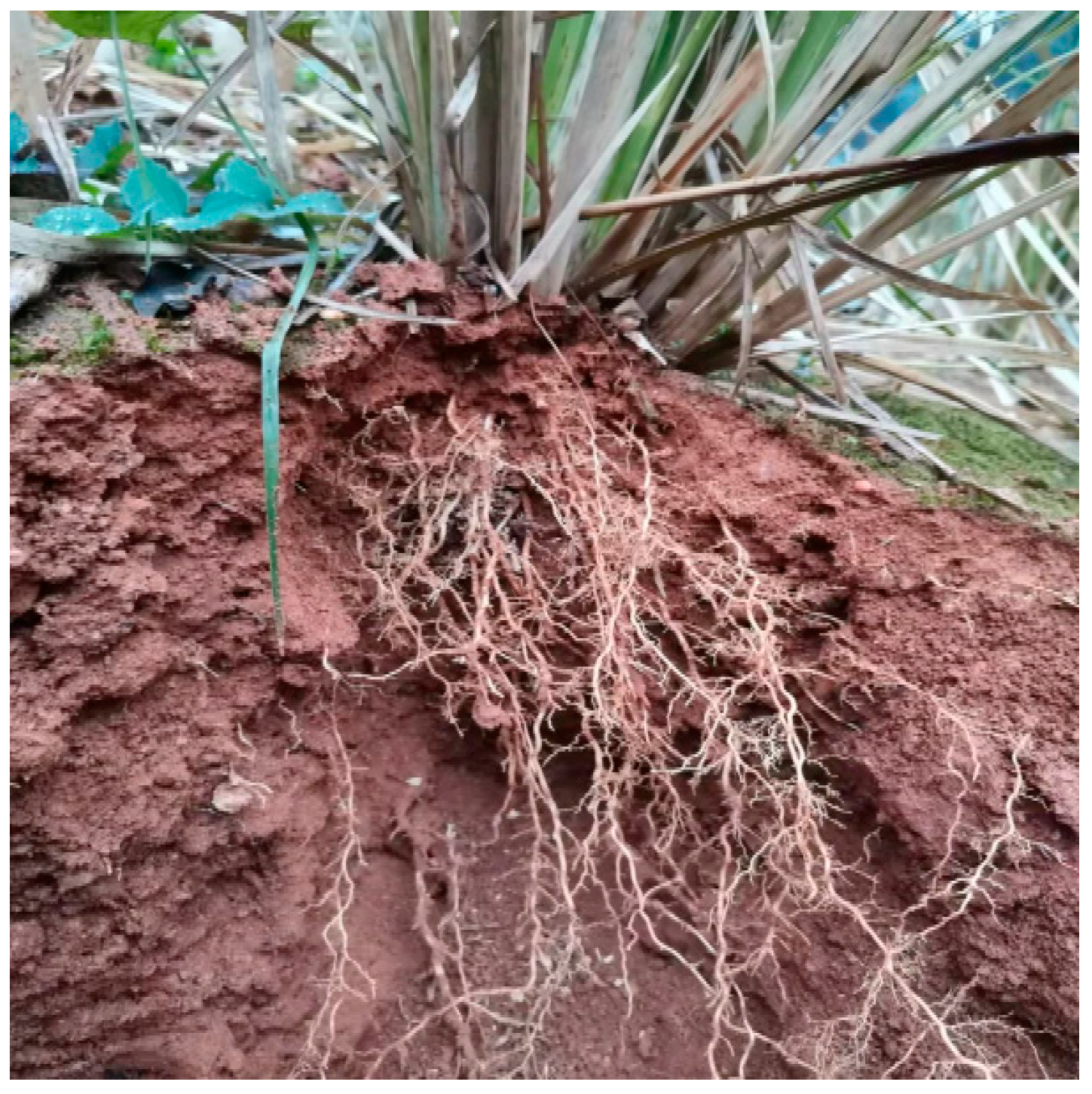

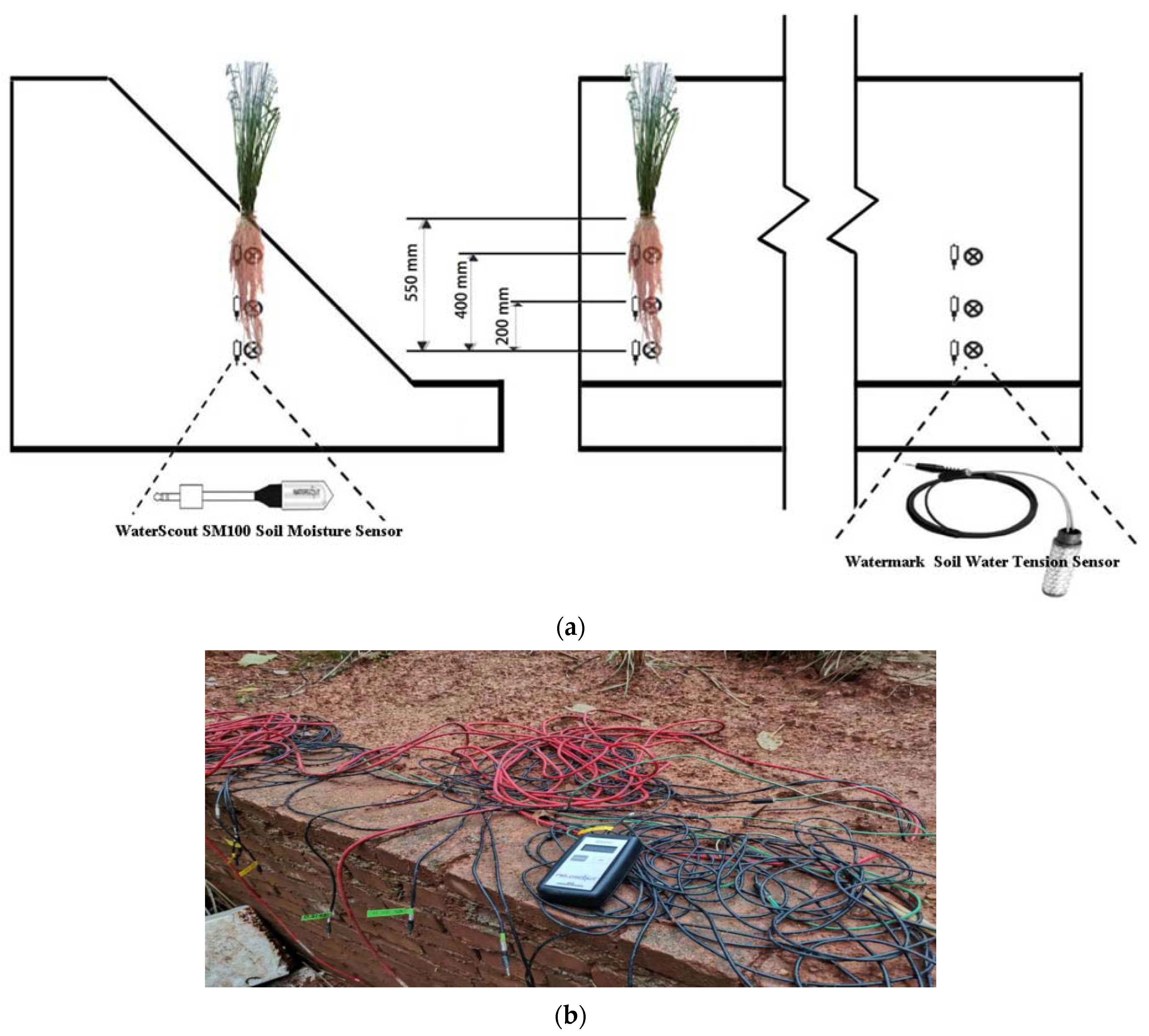

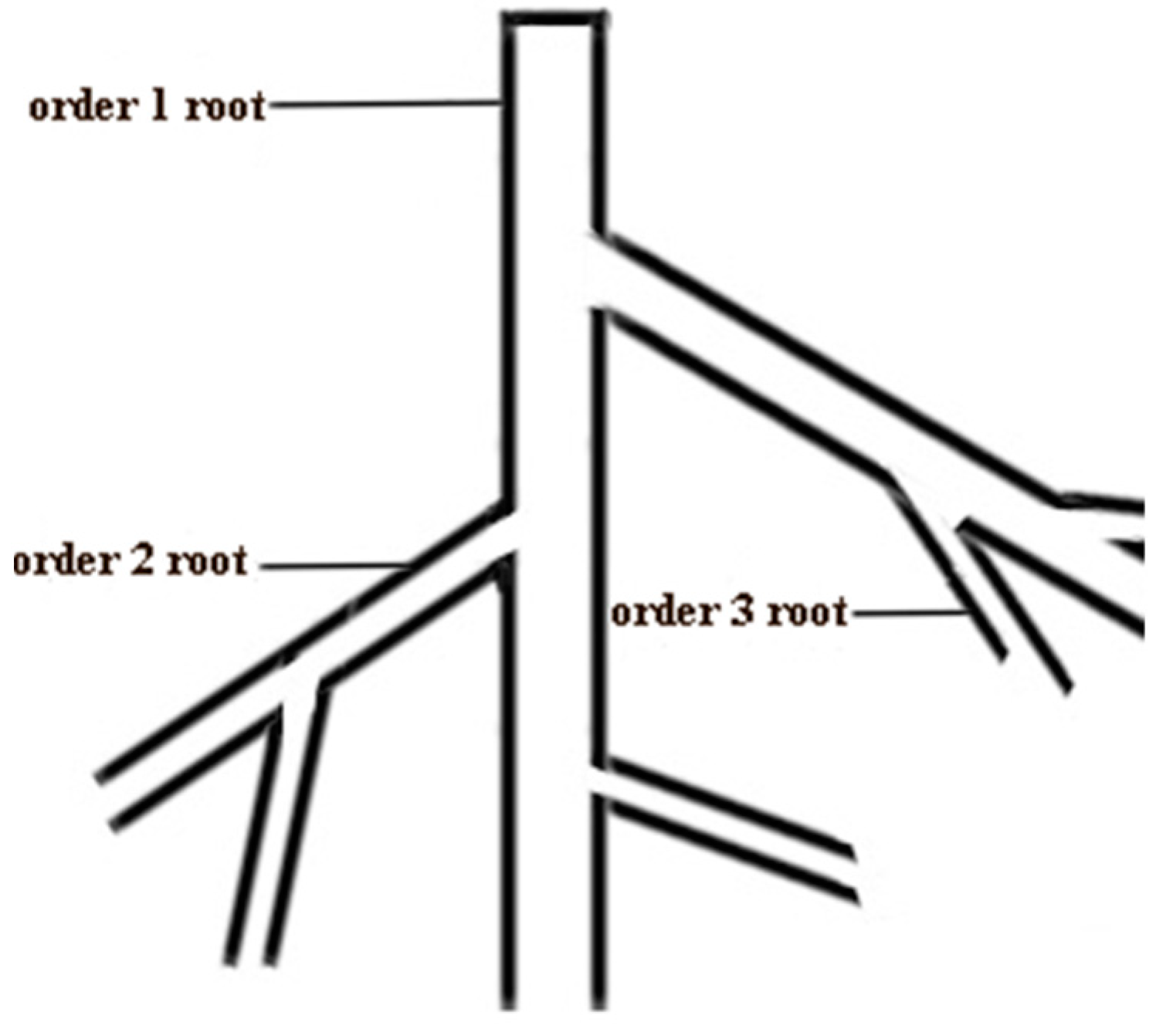
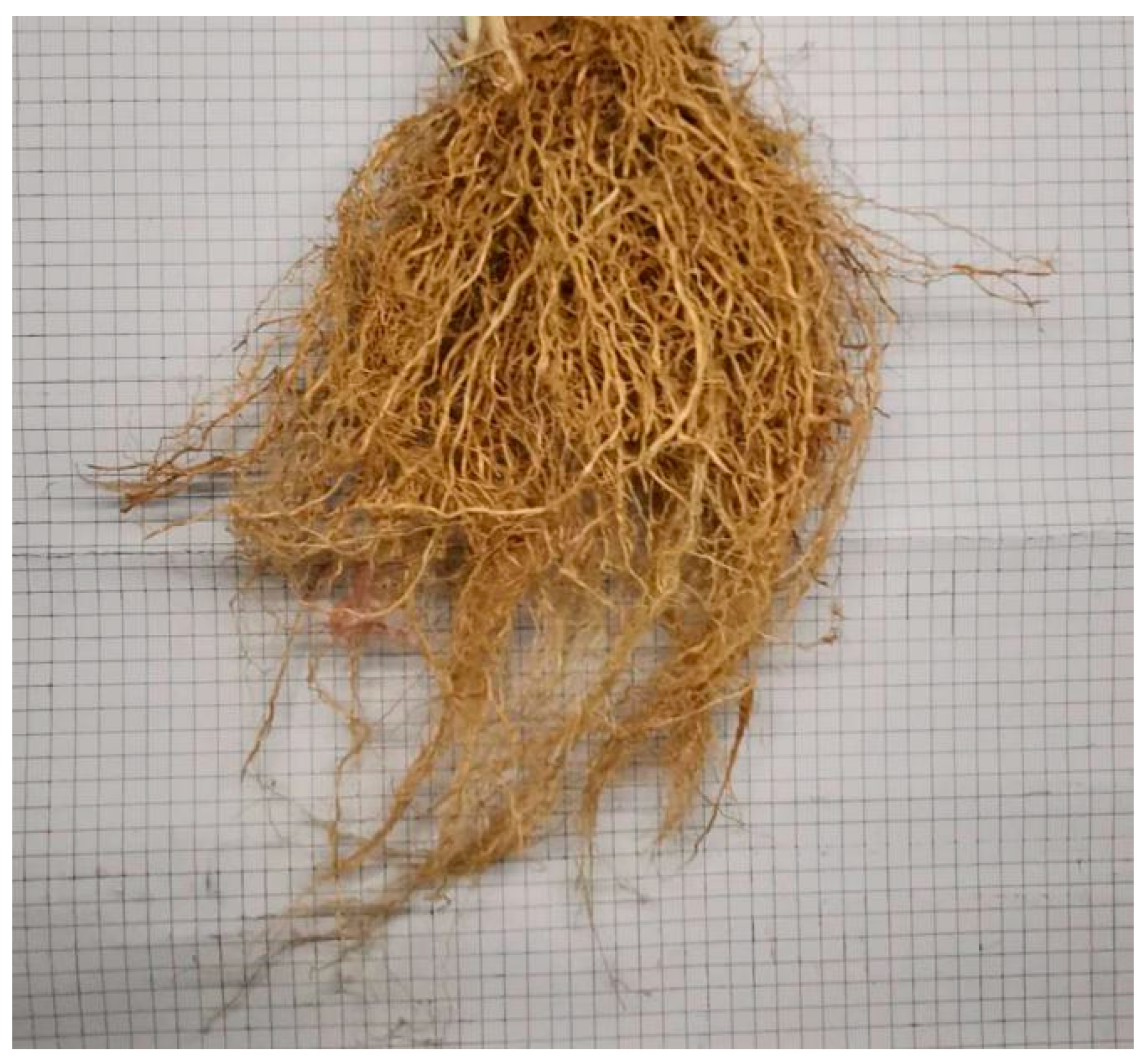

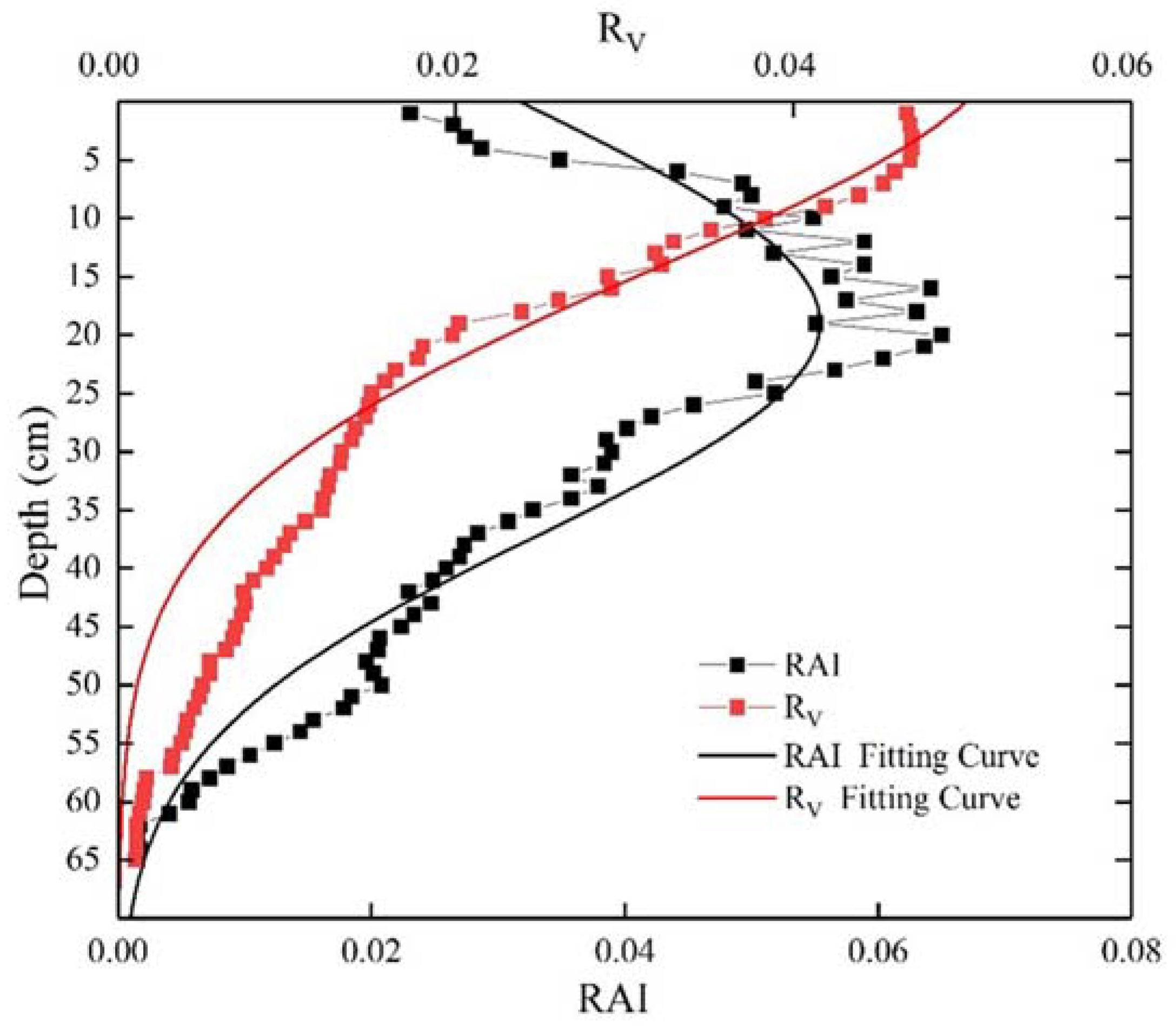


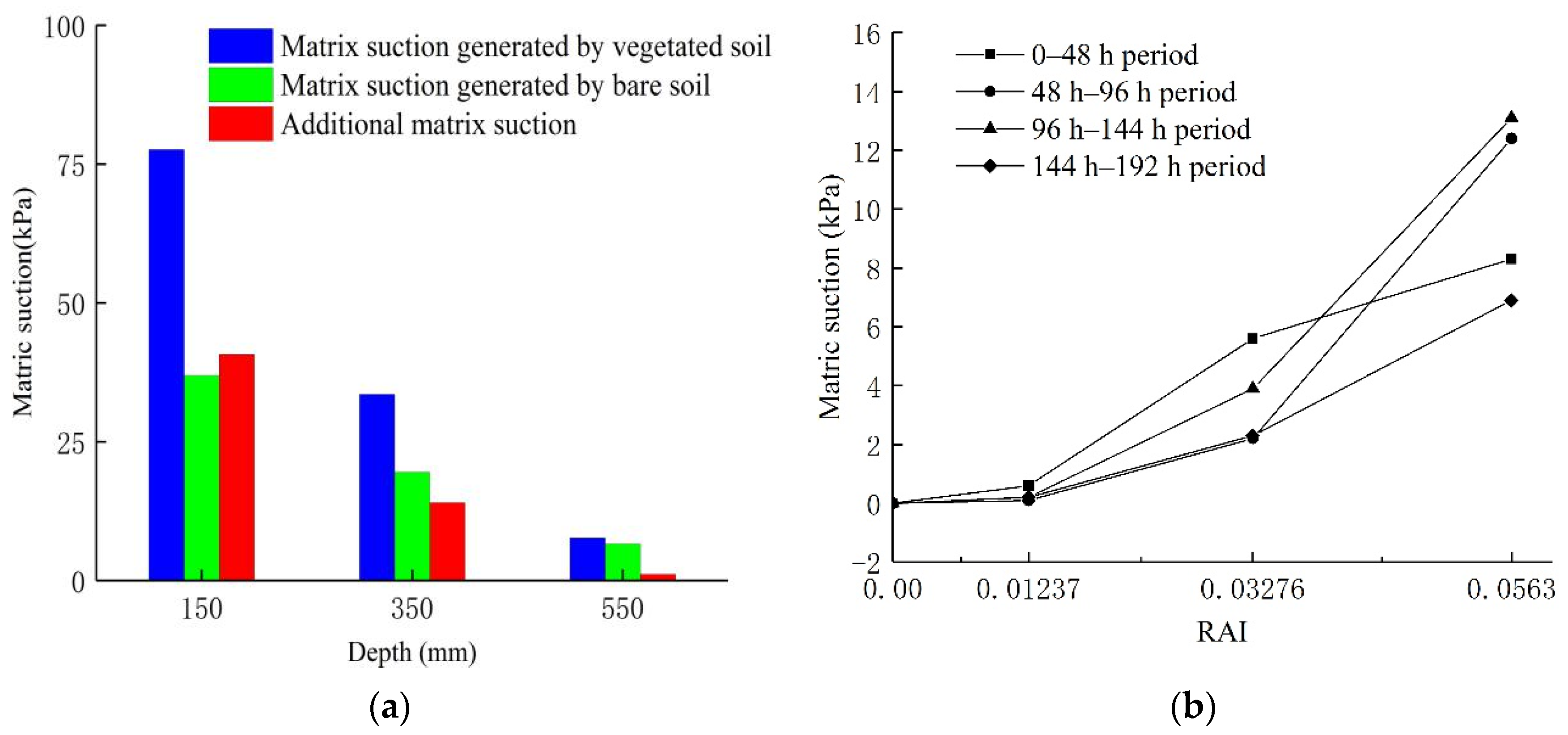
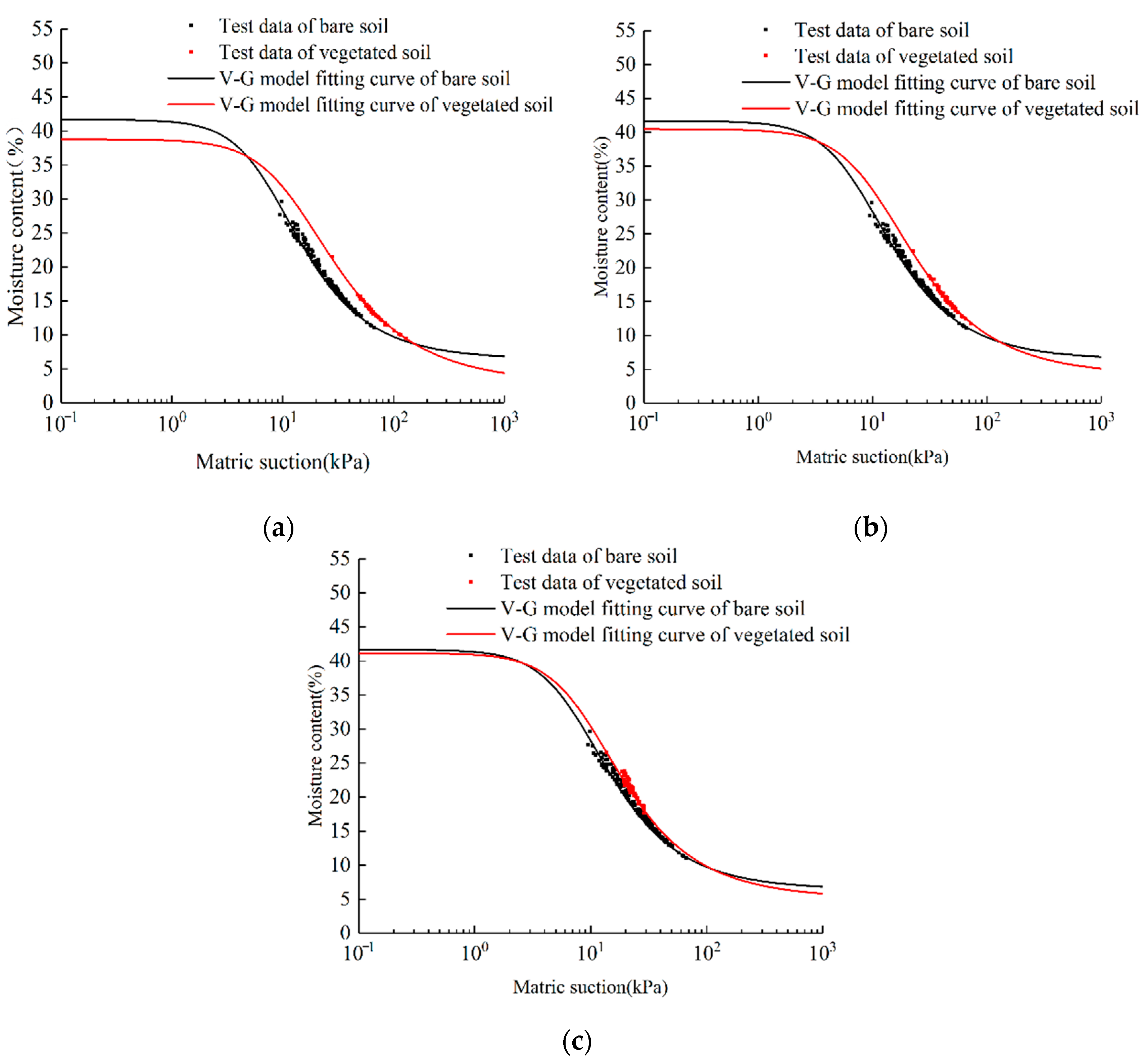
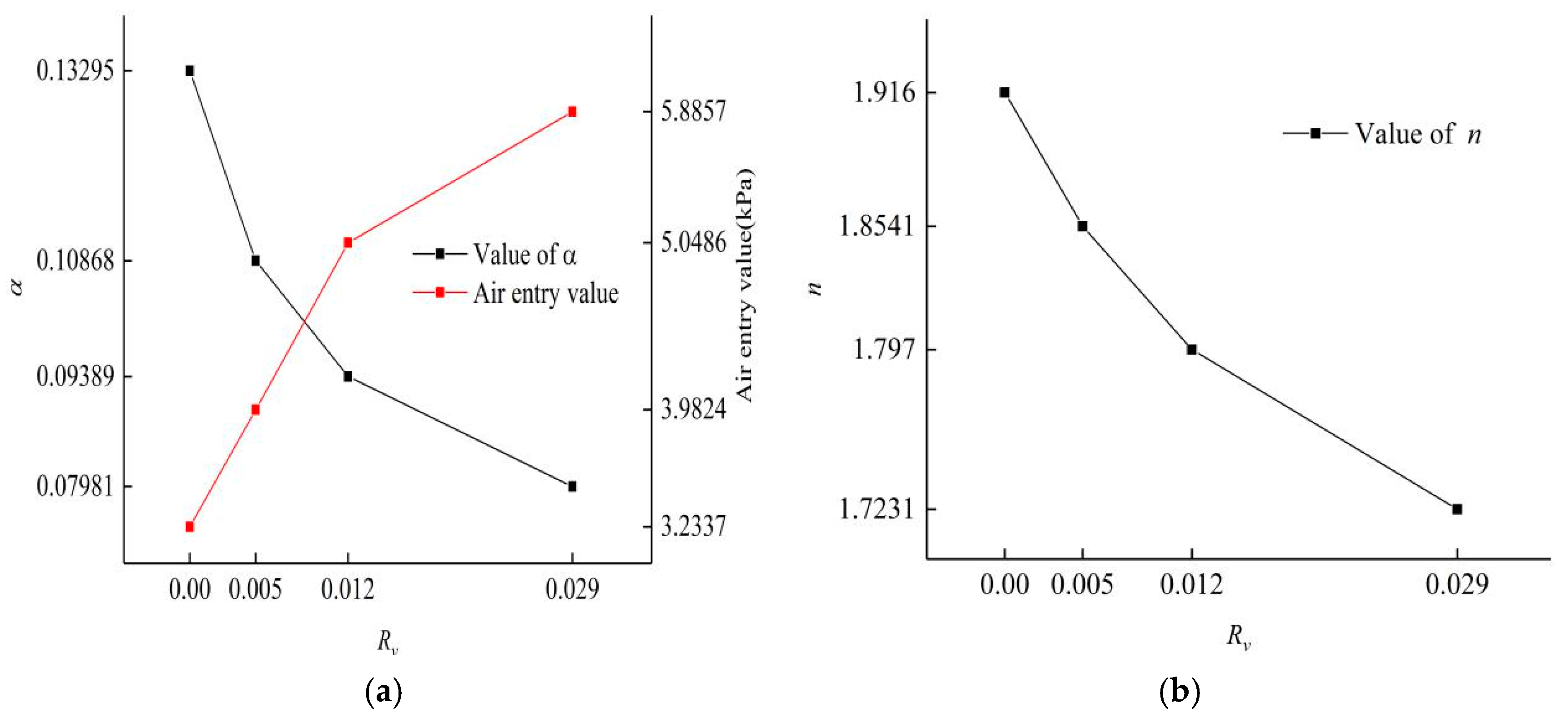
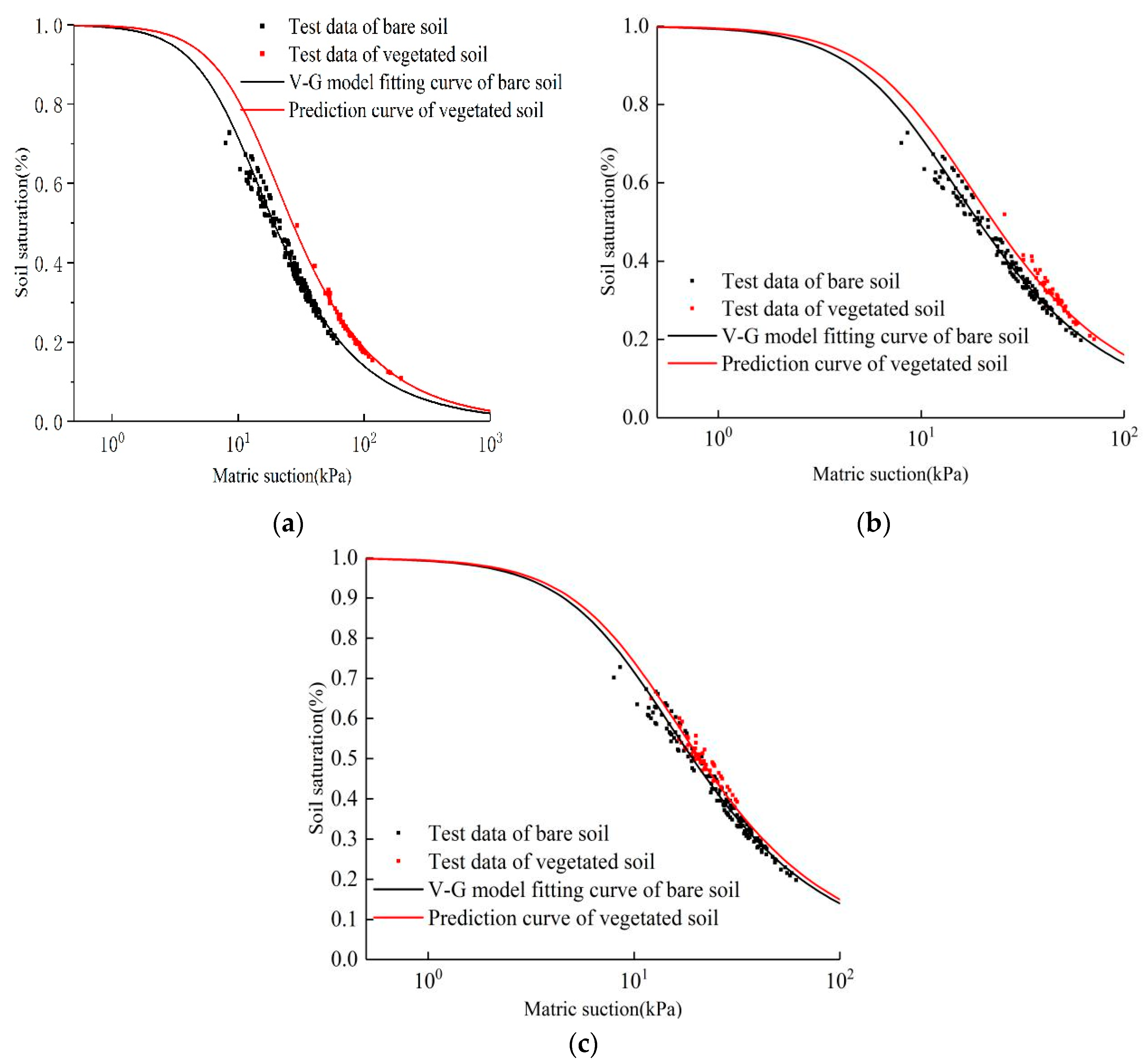
| Proportion | Natural Density (g·cm3) | Maximum Density (g·cm3) | Optimum Moisture Content (%) | Liquid Limit (%) | Plastic Limit (%) | Saturated Penetration Coefficient (mm·h−1) |
|---|---|---|---|---|---|---|
| 2.72 | 1.82 | 1.62 | 21.5 | 41.5 | 25.4 | 1.426 |
| Fitting Parameters | Correlation Coefficient (R2) | |||
|---|---|---|---|---|
| a | b | c | ||
| RAI | 0.05541 | 18.97 | 25.39 | 0.9149 |
| Rv | 0.05241 | −5.9241 | 28.59 | 0.9560 |
| Period | Soil Types | 150 mm | 350 mm | 550 mm |
|---|---|---|---|---|
| 0–48 h | Bare Soil | 16.7 | 7 | 2.8 |
| Vegetated Soil | 25 | 12.6 | 3.4 | |
| 48–96 h | Bare Soil | 3.6 | 2.4 | 1.6 |
| Vegetated Soil | 10.5 | 4.7 | 1.8 | |
| 96–144 h | Bare Soil | 9.9 | 5.9 | 1.3 |
| Vegetated Soil | 23.1 | 9.8 | 1.5 | |
| 144–192 h | Bare Soil | 4.7 | 4.2 | 0.6 |
| Vegetated Soil | 17.1 | 6.4 | 0.7 |
| Soil Types | θs | Fitting Parameters | Correlation Coefficient (R²) | |||
|---|---|---|---|---|---|---|
| θr | α | n | m (1 − 1/n) | |||
| Bare soil | 41.6735 | 6.461 | 0.13295 | 1.916 | 0.4781 | 0.90483 |
| Vetiver covered slope 150 mm soil layer | 38.7736 | 2.885 | 0.07981 | 1.7231 | 0.4197 | 0.92725 |
| Vetiver covered slope 350 mm soil layer | 40.474 | 4.134 | 0.09389 | 1.797 | 0.4435 | 0.93672 |
| Vetiver covered slope 550 mm soil layer | 41.1739 | 5.193 | 0.10868 | 1.8541 | 0.4607 | 0.92746 |
| Soil Types | Basic Parameters of Soil–Water Characteristic Curve | ||
|---|---|---|---|
| Air Entry Value (ψaev) | Inversion Point (ψi, θi) | Slope (ki) | |
| Bare soil | 3.2337 | (11.06, 0.2699) | −0.827 |
| Vetiver covered slope 150 mm soil layer | 5.8857 | (20.74, 0.24) | −0.688 |
| Vetiver covered slope 350 mm soil layer | 5.0486 | (16.74, 0.2567) | −0.742 |
| Vetiver covered slope 550 mm soil layer | 3.9824 | (13.98, 0.2634) | −0.789 |
| Soil Types | Parameters of Gallipoli Model | Rv | ||||
|---|---|---|---|---|---|---|
| m1 | m2 | m3 | m4 | e | ||
| Bare soil | 0.4695 | 1.807 | 3.657 | 2.932 | 0.7161 | 0 |
| Vetiver covered slope 150 mm soil layer | 0.4695 | 1.807 | 3.657 | 2.932 | 0.6332 | 0.029 |
| Vetiver covered slope 350 mm soil layer | 0.4695 | 1.807 | 3.657 | 2.932 | 0.6799 | 0.012 |
| Vetiver covered slope 550 mm soil layer | 0.4695 | 1.807 | 3.657 | 2.932 | 0.6961 | 0.005 |
Disclaimer/Publisher’s Note: The statements, opinions and data contained in all publications are solely those of the individual author(s) and contributor(s) and not of MDPI and/or the editor(s). MDPI and/or the editor(s) disclaim responsibility for any injury to people or property resulting from any ideas, methods, instructions or products referred to in the content. |
© 2023 by the authors. Licensee MDPI, Basel, Switzerland. This article is an open access article distributed under the terms and conditions of the Creative Commons Attribution (CC BY) license (https://creativecommons.org/licenses/by/4.0/).
Share and Cite
Wang, X.; Li, Z.; Chen, Y.; Yao, Y. Influence of Vetiver Root Morphology on Soil–Water Characteristics of Plant-Covered Slope Soil in South Central China. Sustainability 2023, 15, 1365. https://doi.org/10.3390/su15021365
Wang X, Li Z, Chen Y, Yao Y. Influence of Vetiver Root Morphology on Soil–Water Characteristics of Plant-Covered Slope Soil in South Central China. Sustainability. 2023; 15(2):1365. https://doi.org/10.3390/su15021365
Chicago/Turabian StyleWang, Xuan, Zhenyu Li, Yongjun Chen, and Yongsheng Yao. 2023. "Influence of Vetiver Root Morphology on Soil–Water Characteristics of Plant-Covered Slope Soil in South Central China" Sustainability 15, no. 2: 1365. https://doi.org/10.3390/su15021365
APA StyleWang, X., Li, Z., Chen, Y., & Yao, Y. (2023). Influence of Vetiver Root Morphology on Soil–Water Characteristics of Plant-Covered Slope Soil in South Central China. Sustainability, 15(2), 1365. https://doi.org/10.3390/su15021365





